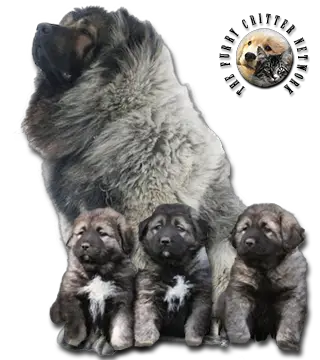Breed Standard
Head: Massive and broad. Distinct stop. Relatively short muzzle with large black or brown nose. Thick, though tight, lips.
Ears: Set on high, drop, cropped short.
Eyes: Small, oval. Dark color.
Body: Slightly longer than tall. Powerful, short neck. Deep, broad, slightly rounded chest. Short loin. Belly moderately tucked up. Broad, muscular back. Broad, muscular, almost horizontal croup.
Tail: Set high, hanging down in the shape of a sickle, hook, or ring. Docked tails are permitted.
Hair: Straight and coarse. Shorter on the head and front of the legs. Extremely thick undercoat of lighter color.Three types:- Long hair with mane, feathering, culottes, and plume.- Short hair without mane, feathering, etc.- Medium length hair, long, but without mane, feathering, culottes, or plume.
Coat: Gray in patches with a variety of nuances, normally light and tending toward red, white, reddish-brown, brindle and piebald and speckled.
Size: Dog: at least 65 cm. (26 in).Bitch: at least 62 cm. (24 in).
Weight: 45 to 65 kg. (99-143.5 lb).
History
For centuries dogs similar to the Caucasian mountain dogs have served shepherds in the Caucasus mountains as livestock guardian dogs, defending sheep from predators, mainly wolves, jackals and bears. Caucasian Shepherd Dogs served as guard dogs, bear hunting dogs and today they work as prison guard dogs in Russia.
During the twentieth century Soviet breeders selected some of these varieties among Caucasian dogs and created the Caucasian Shepherd Dog breed. Caucasian shepherds were first described by the famous Russian cynologist Aleksandr Mazover, noting that the center of distribution of the breed, both in terms of numbers and quality, were Georgia, Azerbaijan, Armenia and Dagestan. These dogs have been used throughout history by many different militaries, but the Caucasian Mountain Dogs existence dates back to ancient times.
While the dogs from different areas of the region shared the general features today present in Caucasian shepherds, Caucasian Shepherds from Georgia were considered to be the best examples of the breed due to their size, powerful musculoskeletal structure, and attractive long hair. For this reason, Georgian SSR became a principal region of cultivation of Caucasian Shepherd Dogs in the Soviet Union.
The breed was definitively accepted by the Federation Cynologique Internationale in 1984, under the patronage of the Soviet Union.
Behavior
This very rustic breed requires little care and adapts easily to all climates. The Caucasian Sheepdog is well-balanced, active, and even-tempered. However, he is suspicious of strangers and may bite. Firm training is required.
The Caucasian Sheepdog requires space and exercise. Weekly brushing is sufficient.
Function
Herder, Guard and Defense Dog, Pet.
Health
Hip dysplasia, obesity and occasional heart problems are known to occur.






